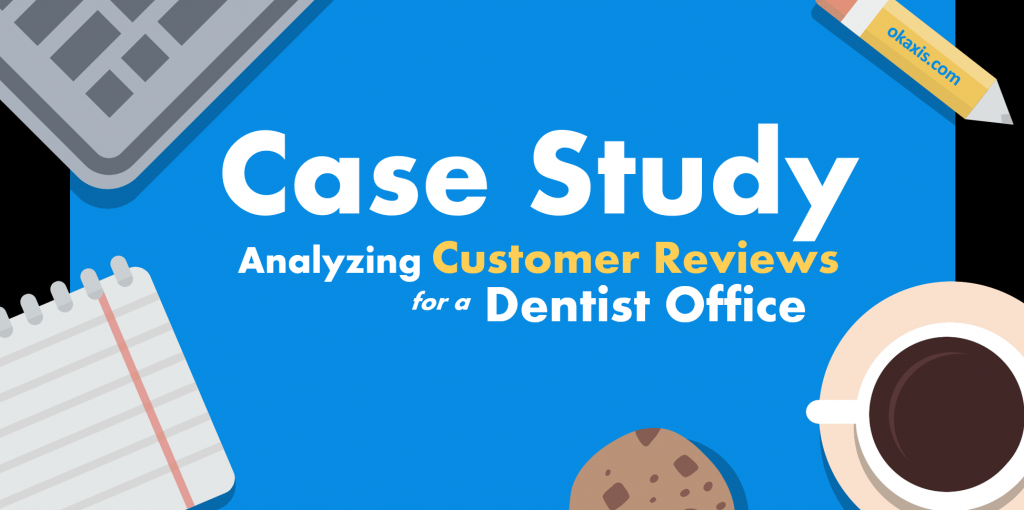Introduction
Let’s continue our series of “Case Study” posts where we get hands-on to see what we can learn from public Customer Review data. Customer Reviews are very important to a business. The last time you interacted with a business what did you do first? You most likely checked your favorite search or social application for recommendations or at least for social proof that the business you are going to interact with has a high social approval rating. Businesses who ignore their bad approval rating are way less likely to attract new and returning customers.
Approach
We are going to use the following approach:
Select a business category. We will select a Dentist Office to analyze.
Identify a business that has 300+ customer reviews for their Google business page
We will use the okaxis customer insights platform as our tool of choice to automatically gather the required data and generate insights for us. Mainly because we don’t have a team of data engineers and data scientists just sitting around waiting to help us.
Goals
- Gather basic Voice of the Customer (VOC) summary statistics for the customer review data we are analyzing. We will be able to answer questions like: How many customers are interacting with this business? How often do their customers interact with them?
- Understand the overall customer sentiment towards this Dentist Office. Do reviewers generally like or dislike this business based on the reviews?
- Get a sense of what specifically reviewers dislike.
- See if we can uncover any interesting trends in the customer reviews.
- And most important, determine what actionable insights can be derived from the customer reviews which may help the business improve.
Voice of the Customer (VOC) Summary Statistics
Let’s do this!
We selected a Dentist Office that has 329 customer reviews so that meets our goal of at least 300 reviews. Think about that for a second. That’s 329 direct, verbatim samples of customer feedback on their business. Definitely a gift.
We can also see there are 329 are unique customers so that means no reviewers left more than a single review.
From the graph, we can see that this business has had fairly consistent numbers in terms of the monthly customer review counts. For a business to get an average of 8 reviews a month indicates they are doing something worth talking about to their customers. Great Job.
So far this month, they received 0 reviews. It is only the sixth day of the month so that makes sense. Last month they had a total of 15 reviews which is over their average.
We see only one review source- 100% of the reviews came from Google. It would be interesting to connect additional data sources (like Facebook for example) to see if we see the same pattern. Okaxis makes it super easy to connect to other data sources. Simply click a button and connect your account for that data source and the reviews flow in.
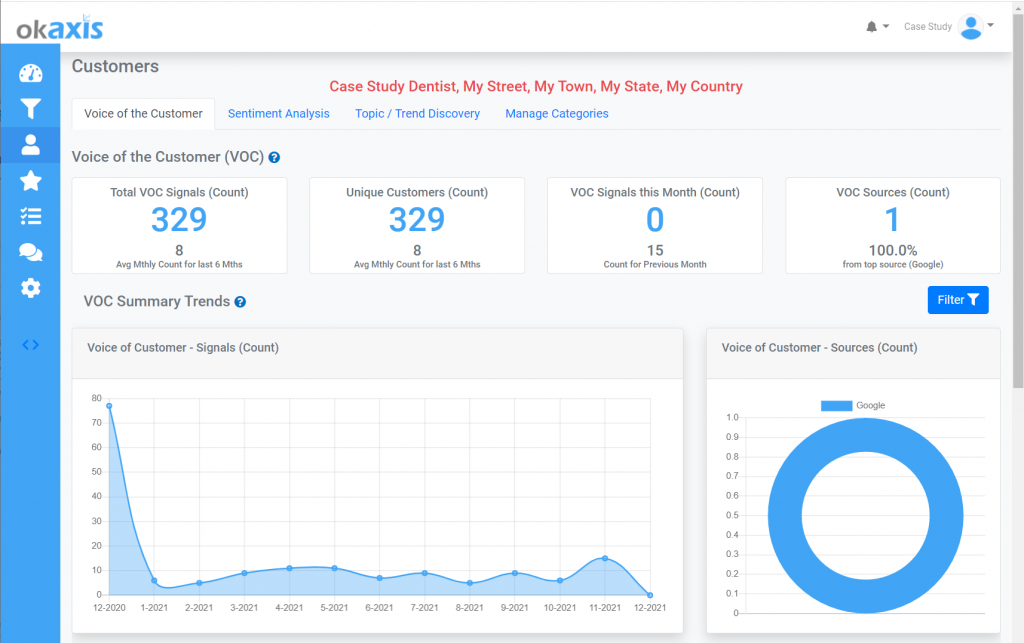
Another thing to investigate is the year over year data volumes? An average of 8 reviews a month would net about 96 reviews per year. Looking at the graph below, we can see that reviews for this business started ramping up at the end of 2016 and continued grow. 2020 saw a significant decline in the count of customer reviews. In fact, looks like they only received around three-quarters of the reviews they received from the year before. This is a similar trend we see in other Dentists Offices and businesses in general due to the Covid 19 pandemic.
This will be an interesting thing to look at when we dig into the data further.
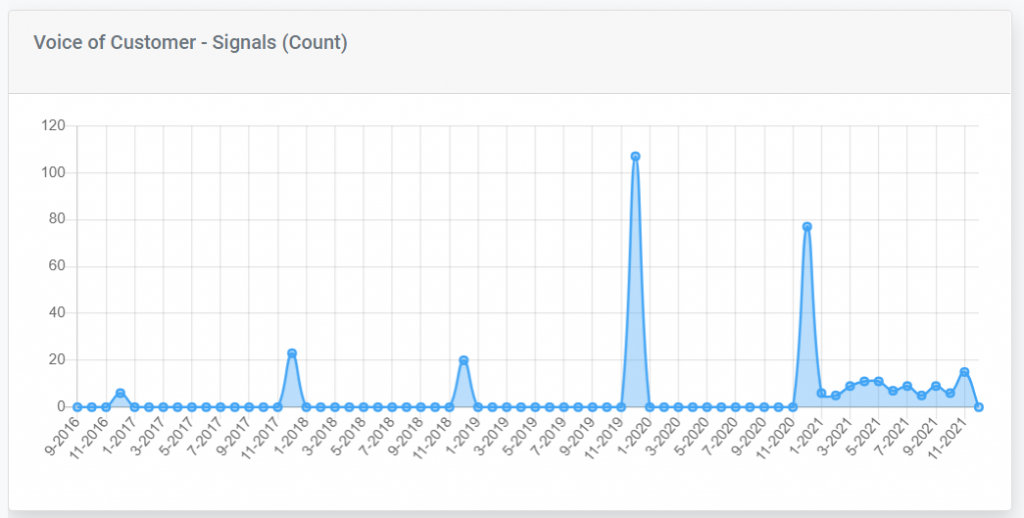
Customer Sentiment Summary
Sentiment is a measure of how ‘Positive’, ‘Neutral’, or ‘Negative’ your customers feel about your business or brand.
It’s fabulous to see a business with an overall 80%+ positive sentiment (actual is 82.1%). The last 6 month average has dropped by 11.5 points (from 82.1 to 70.6) which is significant and something we will want to continue to watch and dig into in our analysis.
We can see an overall 14.9% Neutral Sentiment Average which has increased to 25.5% over the last 6 months average. And finally, an overall 3.0 % Negative Sentiment Average which has increased to 3.9% over the last 6 months average.

Looking at the 12 month trend for negative sentiment, we can see there were no negative reviews from 1/2021 – 10/2021, then a big spike in 11/2021. We will note this spike for now and dig into the details as we progress to see if we can find anything actionable which would help this business improve.
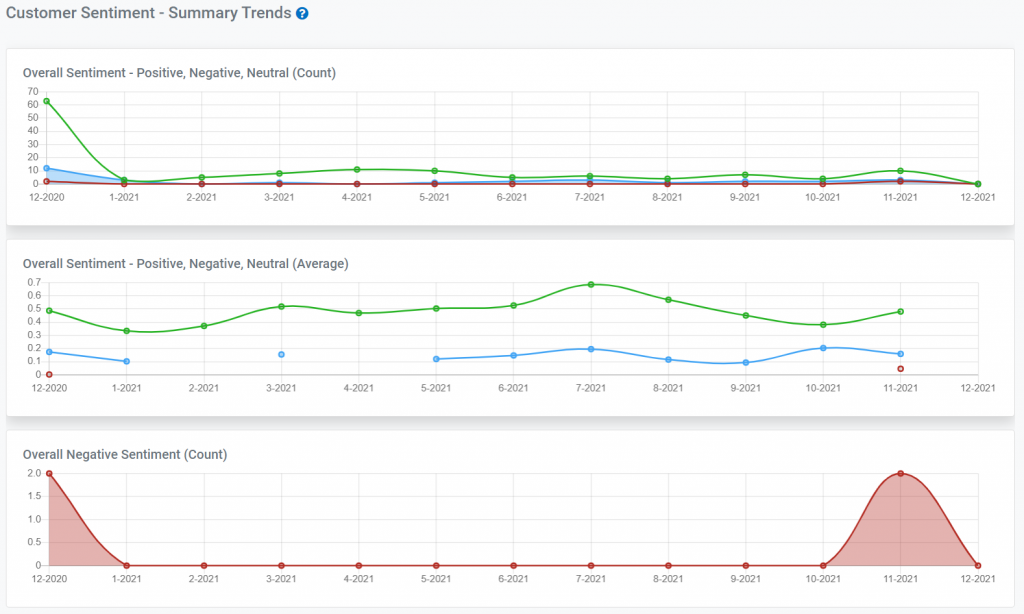
Customer Sentiment – Subjectivity
Subjectivity is a score between 0 and 100% where 0 is very objective or factual and 100% is very subjective or opinion.
We can see an overall 57.2% Total Subjectivity % Average which has increased to 59.0% over the last 6 months average. For this type of business and for customer reviews in general, a subjectivity score of 60% is on benchmark. The Subjectivity average for 1/21 is lower where 8/21 is higher than other monthly averages so we will take a look at this further to see what is happening.

Customer Sentiment – Word Frequencies
Looking at positive and negative word frequencies is a great way to quickly identify sentiment trends in your data.
Top Positive Word Frequencies – the top 10 positive words in this businesses reviews are:
- Great
- Friendly
- Comfortable
- Nice
- Best
- First
- Good
- Amazing
- Excellent
- Kind
Scanning other positive high-frequency words (words that occur in multiple reviews) that we may want to drill into would be: love, clean, smile, pleasant, courteous, sweet, safe, easy, fit, warm, calm, respectful, funny, and confident…
Top Negative Word Frequencies – the top 10 negative words in this businesses reviews are:
- Few
- Past
- Bad
- Due
- Uncomfortable
- Terrible
- Less
- Hate
- Down
- Disappointed
Scanning other negative high-frequency words (words that occur in multiple reviews) that we may want to drill into would be: hard, frustrating, painful, crazy, scary, trouble, late, cold, disliked, mean, tedious, complicated, ridiculous, difficult, expensive, horrible…
Let’s dig into some of these high-frequency negative words to see if we can find any trends or actionable improvement areas.
okaxis lets you easily search across all your reviews… This can save you a ton of time especially when you have thousands of reviews from multiple review sites (data sources).
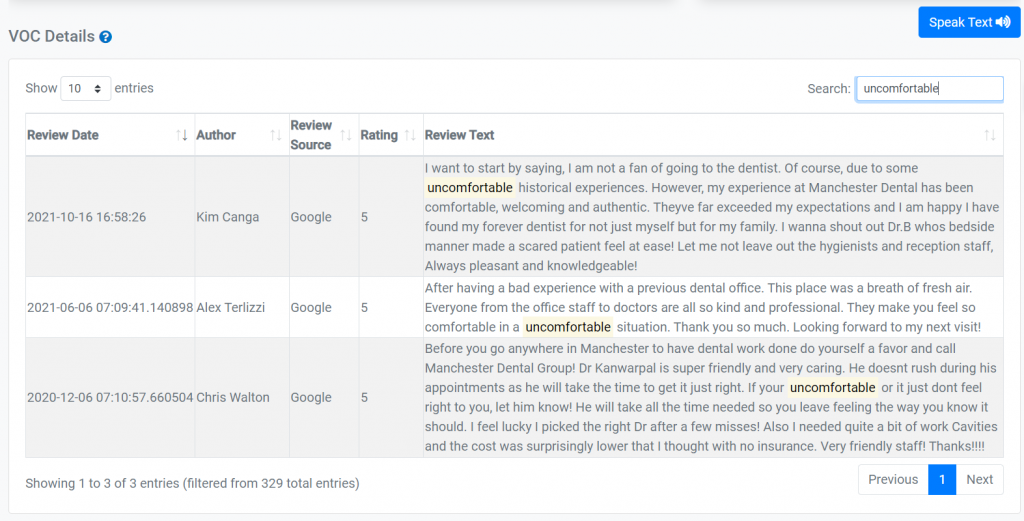
Searching the keyword “uncomfortable” filters the reviews down to only those that contain that word:
- “I want to start by saying, I am not a fan of going to the dentist. Of course, due to some uncomfortable historical experiences.”
- “They make you feel so comfortable in a uncomfortable situation.”
- “If your uncomfortable or it just don’t feel right to you, let him know!”
In this case, the word “uncomfortable” is used in a positive sense. Nothing too interesting to look at here…

Searching the keyword “frustrating” filters the reviews down to only those that contain that word:
- “The people here are very nice. Unfortunately it has been a bit frustrating.”
- “...been frustrating because I cant seem to get past the receptionist. Have not been able to connect with the doctor.”
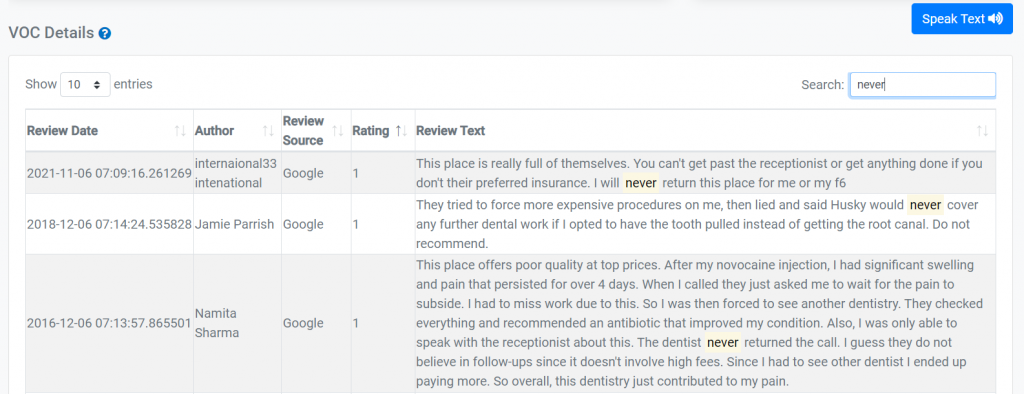
Searching the keyword “never” filters the reviews down to only those that contain that word:
- “I will never return to this place“
- “They said [Insurance] would never cover any further dental work if I opted to have the tooth pulled instead of getting the root canal.“
- “The dentist never returned the call.“
Visually Discovering Trends
“Word Clouds” help you to visually understand the word or phrase frequency in your data… The more times a word or phrase is mentioned, the larger the text.
Let’s look at a few out of the box Categories that okaxis provides. The “Customer Service Promoters” category yields 152 mentions pertaining to customer service terms. Additionally 100% of the discussion around these terms were positive. The top terms (largest) talked about relating to customer service were Friendly, Great Service, Very Professional, Courteous, etc. Okaxis allows you to customize categories and also create new ones. We could add our specific keywords to get a more in depth understanding. Note that we can also see the details under the word cloud so we can see the exact customer review text. We can search this list or page through all results.
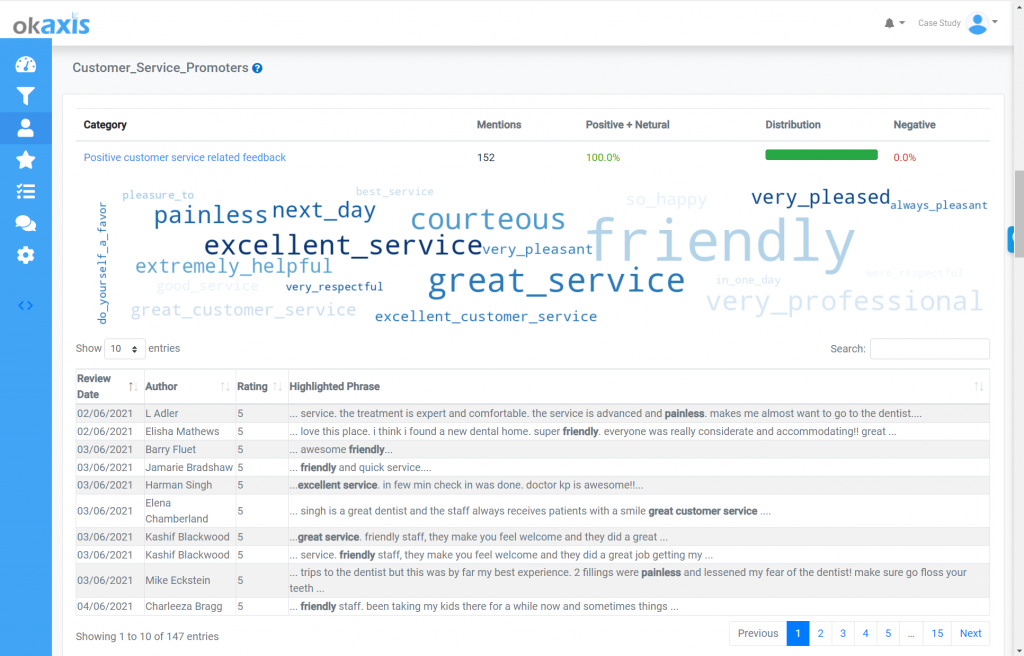
Looking at the “Reputation Promotors” category, which shows us positive opinions related to company reputation, we see that there were 92 mentions, of which 100% were positive, pertaining to this category.
The top terms (largest) talked about regarding company reputation are highly recommend, definitely recommend, would recommend, very professional, etc
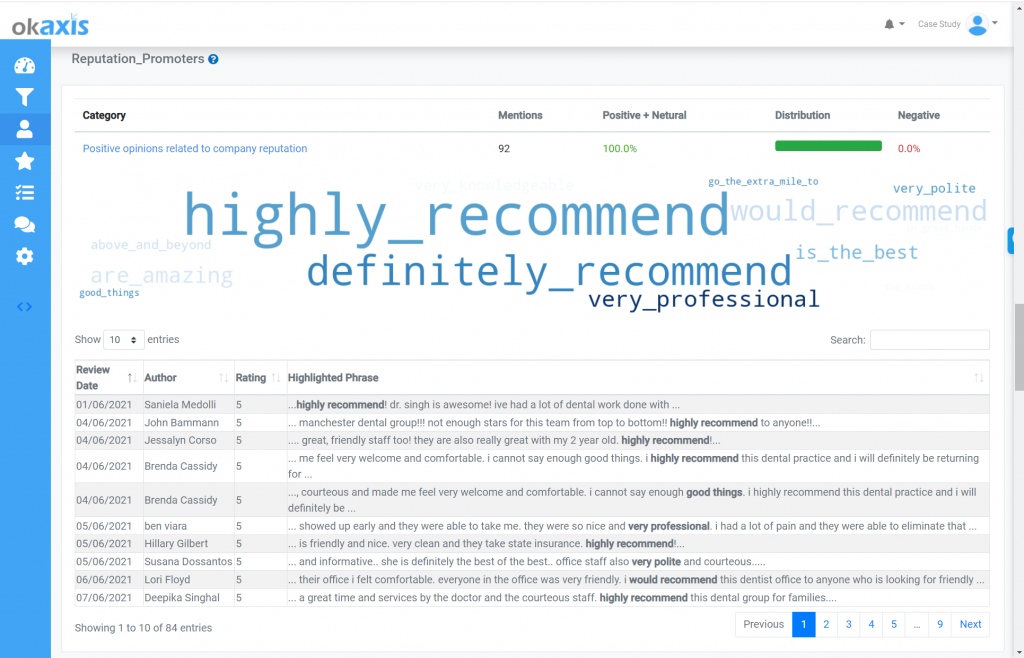
Looking at the “Customer Experience Promotors” category, which shows us positive opinions related to the customer experience, we see that there were 55 mentions, of which 100% were positive, pertaining to this category.
The top terms (largest) talked about regarding company reputation are Very Friendly, A Great Experience, Wonderful Experience, Is Amazing, etc
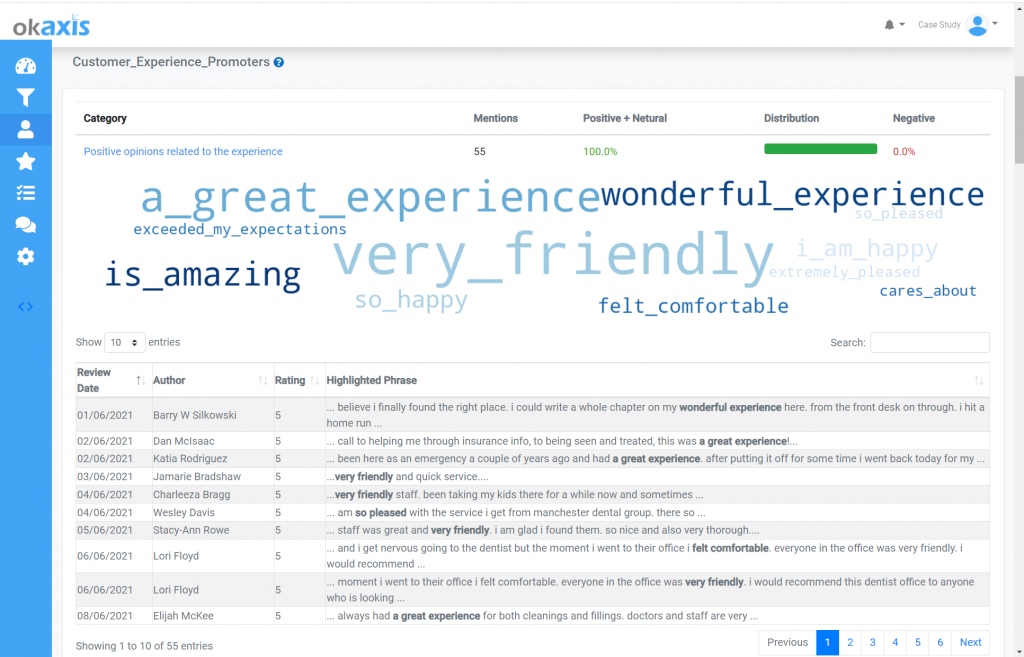
Key Findings & Action Plan
Ok so how did we do? I’d have to say, looking at the goal we set out to achieve, we certainly achieved it!
We were able to:
- Gather basic Voice of the Customer (VOC) summary statistics on this business we analyzed. We now know how many customers are interacting with this business AND how often their customers interact with them.
- Understand the overall customer sentiment for this business. It is very clear that reviewers really like this business based on their reviews.
- Understand what specifically reviewers dislike. This business had very few negative reviews overall. When reviewers did complain they were focused in these areas: Insurance claims, scheduling issues, doctor availability.
- Discover some interesting trends in the customer reviews. We now know that the majority of reviewers indicated that this business was Friendly, had Great Service, was Very Professional and Courteous, etc.
- Highlight some areas where the business could double down on what it is going good and also improve where reviewers identified short comings.
